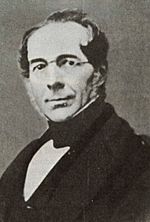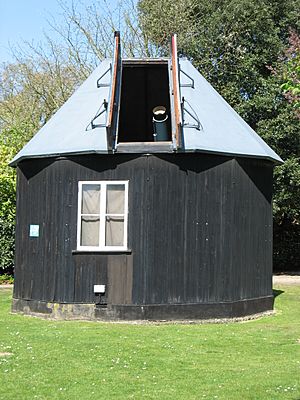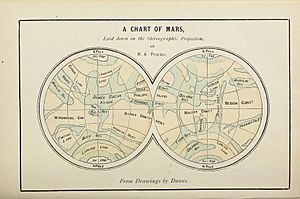William Rutter Dawes facts for kids
Quick facts for kids
William Rutter Dawes
|
|
|---|---|

A photograph, c. 1863
|
|
| Born | 19 March 1799 |
| Died | 15 February 1868 (aged 68) |
| Citizenship | English |
| Awards | Gold Medal of the Royal Astronomical Society (1855) |
| Scientific career | |
| Fields | Astronomy |
William Rutter Dawes (born March 19, 1799 – died February 15, 1868) was an English astronomer. He was known for his amazing eyesight, which earned him the nickname "eagle-eyed." He made important observations of stars and planets, especially Mars.
Contents
Early Life and Career
William Rutter Dawes was born in London on March 19, 1799. His father, also named William Dawes, was an astronomer too.
William Rutter Dawes first became a doctor in 1825. Later, in 1828, he became a pastor. He worked at a church in Ormskirk, Lancashire. He left this job in 1837 because he was not well. When his old church faced money problems in 1843, Dawes helped them out.
Contributions to Astronomy
Dawes was very good at observing the night sky. He carefully measured many double stars. These are two stars that appear very close together from Earth. He also observed planets in our solar system.
He was good friends with another astronomer, William Lassell. People called Dawes "eagle-eyed" because he could see very fine details through his telescope.
Dawes' Private Observatory
In 1856, Dawes built his own private observatory. It was at his home, Hopefield House, in Haddenham, Buckinghamshire. One of his telescopes is still used today. It is an eight-inch (200mm) refractor telescope made by Cooke. This telescope is now at the Cambridge Observatory. It is known as the Thorrowgood Telescope.
Observing Mars
Dawes made many detailed drawings of Mars in 1864. This was when Mars was closest to Earth, a time called an opposition. In 1867, another astronomer named Richard Anthony Proctor used Dawes' drawings to create a map of Mars. Proctor even named two features on Mars after Dawes to honor his work.
Recognition for His Work
For his important work in astronomy, Dawes became a member of two major groups. He was elected a Fellow of the Royal Astronomical Society in 1830. Later, in 1865, he became a Fellow of the Royal Society. This is a very high honor for scientists. Famous astronomers like G. B. Airy and J. F. W. Herschel supported his election.
Awards and Honors
In 1855, William Rutter Dawes received a very special award. He won the Gold Medal of the Royal Astronomical Society. This medal is given to people who have made outstanding contributions to astronomy.
Legacy and Namesakes
William Rutter Dawes left a lasting mark on astronomy. Several things are named after him:
- The Dawes crater on the Moon.
- The Dawes crater on Mars.
- A gap in Saturn's C Ring was once called the Dawes Gap.
- An optical idea called the Dawes limit is also named after him. This limit describes how close two objects can be and still be seen as separate through a telescope.
Family Life
William Rutter Dawes was married two times. His first wife was Mary Scott. They married in 1824. His second wife was Ann Welsby. They married in 1842.
Images for kids




